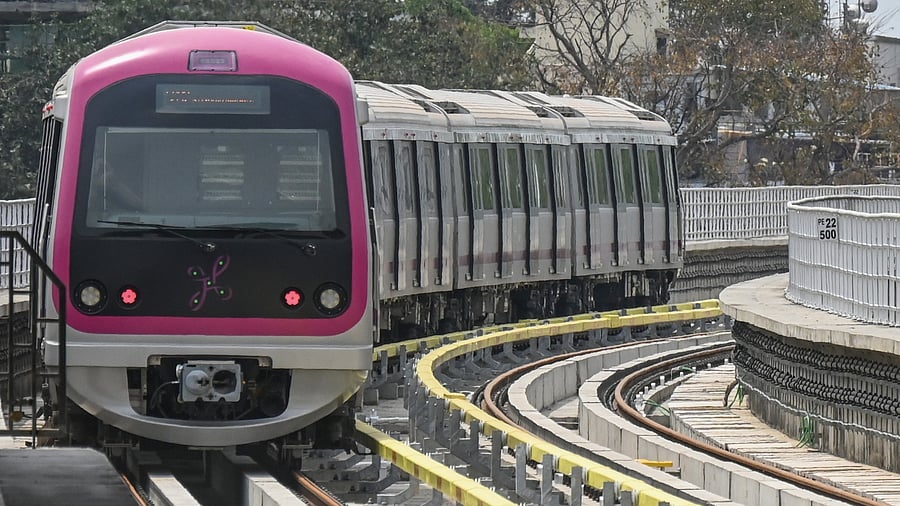
A study says rationalised fares could significantly increase metro usage by Bengaluru’s low-income workforce.
Credit: DH File Photo/SK Dinesh
Fare reduction to improve metro ridership is integral to Bengaluru’s preparedness for future traffic, a study on travel patterns of low and low-middle income commuters has concluded.
The study by researchers at the National Institute of Advanced Studies (NIAS) argued that rationalised fares could significantly increase metro usage by Bengaluru’s low-income workforce, leading to impressive economic and environmental benefits.
Between July and September 2021, the researchers surveyed 436 households around existing metro stations and 914 households around proposed stations. Of the respondents living around existing stations, 65.71% said high costs stopped them from using the metro (figures in box). Around 80% of people living around under-construction stations expressed eagerness to use the metro.
The study covered 5,073 respondents from 1,350 low and low-middle income households in 16 wards.
The respondents lived within a 1.5-km radius of six existing stations in Phase 1 and 10 that were under construction at the time of the survey, in Phases 2, 2A, and 2B.
The findings of the study by Tanmay Ghosh, Tejal Kanitkar, and R Srikanth from NIAS’ Energy, Environment, and Climate Change programme were published in the journal ‘Case Studies on Transport Policy’. Ghosh said the findings revealed “disproportionately higher” amounts of money spent by low-income groups on travel.
Households with a monthly income of less than Rs 10,000 constituted 81% of the sample. The median monthly household income was Rs 7,805.
“Our results show that the modal shift from bus and two-wheelers to metro would imply an even higher proportion of spending on travel at current tariffs. If the aim is to encourage a shift from private two-wheeler use or even bus use to the metro as a more sustainable alternative, the element of affordability for the largest working section of the population must be considered a priority,” Ghosh told DH.
Study areas
The study areas included six wards with metro stations (HMT, Bagalagunte, Nagapura, Benniganahalli, Deepanjalinagar, and Yelachenahalli) and 10 wards with under-construction stations (Bellanduru, Vignananagar, Kadugodi, Shanthinagar, Jnanabharathi, Pattabhiramnagar, Singasandra, Kempegowda, Byatarayanapura, and Horamavu).
Switching modes
The researchers created two 2031 scenarios — a Business As Usual (BAU) projection, assuming that the modal share of transportation (metro, bus, autorickshaw, and private transport) would remain the same, and an Affordable Metro Service (AMS) projection, assuming that metro and bus fares are the same for distances longer than 5 km.
A ridership shift from other motorised modes to the metro, the study said, could improve the metro’s modal share in motorised trips from 7% (BAU) to 17% (AMS), in 2031. This could also lead to a substantial increase in daily revenue for the metro operator, from Rs 3.4 crore to Rs 5.9 crore, the study estimated.
In August this year, metro’s average daily ridership hit a record 6.24 lakh. RITES, in a 2019 study, has projected a metro ridership of three million (of the total motorised ridership of 16 million) by 2031. The NIAS analysis, however, indicated that the ridership would only be 1.3 million.
“An integrated public transportation agency which can coordinate the operation of both buses and metro, as proposed by the recent bill of BMLTA, is an important step to ensure that the city achieves its mobility and sustainability targets,” Ghosh said. NIAS has been engaging with state agencies through workshops to convert in-house research to policy briefs which are then circulated to policymakers and other stakeholders.
Reasons for not using metro (where stations are accessible)
Expensive: 65.71%
No service in work direction: 10.09%
Safety and security concerns: 10.09%
Lack of first and last-mile connectivity: 6.63%
Comfort (availability of seating/standing space): 4.03%
Lack of parking facility at station: 2.59%
Low frequency of service: 0.58%
Lack of accessibility: 0.29%
Highlights - null